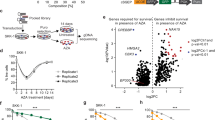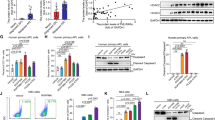Abstract
Non-liganded retinoic acid receptors (RARs) repress transcription of target genes by recruiting the histone deacetylase complex1,2,3 through a class of silencing mediators termed SMRT or N-CoR4,5. Mutant forms of RARα, created by chromosomal translocations with either the PML (for promyelocytic leukaemia)6,7,8 or the PLZF (for promyelocytic leukaemia zinc finger)9,10 locus, are oncogenic and result in human acute promyelocytic leukaemia (APL). PML–RARα APL patients achieve complete remission following treatments with pharmacological doses of retinoic acids (RA); in contrast, PLZF–RARα patients respond very poorly, if at all11. Here we report that the association of these two chimaeric receptors with the histone deacetylase (HDAC) complex helps to determine both the development of APL and the ability of patients to respond to retinoids. Consistent with these observations, inhibitors of histone deacetylase dramatically potentiate retinoid-induced differentiation of RA-sensitive, and restore retinoid responses of RA-resistant, APL cell lines. Our findings suggest that oncogenic RARs mediate leukaemogenesis through aberrant chromatin acetylation, and that pharmacological manipulation of nuclear receptor co-factors may be a useful approach in the treatment of human disease.
This is a preview of subscription content, access via your institution
Access options
Subscribe to this journal
Receive 51 print issues and online access
$199.00 per year
only $3.90 per issue
Buy this article
- Purchase on Springer Link
- Instant access to full article PDF
Prices may be subject to local taxes which are calculated during checkout




Similar content being viewed by others
References
Alland, L. et al. Role for N-CoR and histone deacetylase in Sin3-mediated transcriptional repression. Nature 387, 49–55 (1997).
Heinzel, T. et al. Acomplex containing N-CoR, mSin3 and histone deacetylase mediates transcriptional repression. Nature 387, 43–48 (1997).
Nagy, L. et al. Nuclear receptor repression mediated by a complex containing SMRT, mSin3A, and histone deacetylase. Cell 89, 373–380 (1997).
Chen, J. D. & Evans, R. M. Atranscriptional co-repressor that interacts with nuclear hormone receptors. Nature 377, 454–457 (1995).
Horlein, A. J. et al. Ligand-independent repression by the thyroid hormone receptor mediated by a nuclear receptor co-repressor. Nature 377, 397–404 (1995).
Kakizuka, A. et al. Chromosomal translocation t(15; 17) in human acute promyelocytic leukemia fuses RARα with a novel putative transcription factor, PML. Cell 66, 663–674 (1991).
de Thé, H. et al. The PML-RARα fusion mRNA generated by the t(15; 17) translocation in acute promyelocytic leukemia encodes a functionally altered RAR. Cell 66, 675–684 (1991).
Kastner, P. et al. Structure, localization and transcriptional properties of two classes of retinoic acid receptor alpha fusion proteins in acute promyelocytic leukemia (APL): Structural similarities with a new family of oncoproteins. EMBO J. 11, 629–642 (1992).
Chen, Z. et al. Fusion between a novel Krüppel-like zinc finger and the retinoid acid receptor-α locus due to a variant t(11; 17) translocation associated with acute promyelocytic leukemia. EMBO J. 12, 1161–1167 (1993).
Chen, Z. et al. PLZF-RARα fusion proteins generated from the variant t(11; 17) (q23; q21) translocation in acute promyelocytic leukemia inhibit ligand-dependent transactivation of wild type retinoid acid receptors. Proc. Natl Acad. Sci. USA 91, 1178–1182 (1994).
Licht, J. D. et al. Clinical and molecular characterization of a rare syndrome of acute promyelocytic leukemia associated with translocation (11; 17). Blood 85, 1083–1094 (1995).
Licht, J. D. et al. Reduced and altered DNA-binding and transcriptional properties of the PLZF-retinoic acid receptor-α chimera generated in t(11; 17)-associated acute promyelocytic leukemia. Oncogene 12, 323–336 (1996).
Jansen, J. H. et al. Multimeric complexes of the PML-retinoic acid receptor α fusion protein in acute promyelocytic leukemia cells and interference with retinoid and peroxisome-proliferator signaling pathways. Proc. Natl Acad. Sci. USA 92, 7401–7405 (1995).
Rousselot, P. et al. The PML-RARα gene product of t(15; 17) translocation inhibits retinoic acid-induced granulocytic differentiation and mediated transactivation in human myeloid cells. Oncogene 9, 545–551 (1994).
Li, J.-Y. et al. Sequence-specific DNA binding and transcriptional regulation by the promyelocytic leukemia zinc finger protein. J. Biol. Chem. 272, 22447–22455 (1997).
Dong, S. et al. Amino-terminal protein-protein interaction motif (POZ-domain) is responsible for activities of the promyelocytic leukemia zinc finger-retinoic acid receptor-α fusion protein. Proc. Natl Acad. Sci. USA 93, 3624–3629 (1996).
Ruthardt, M. et al. Opposite effects of the acute promyelocytic leukemia PML-retinoic acid receptor α (RARα) and PLZF-RARα fusion proteins on retinoic acid signalling. Mol. Cell. Biol. 17, 4859–4869 (1997).
Dhordain, P. et al. Corepressor SMRT binds the BTB/POZ repressing domains of the LAZ3/BCL6 oncoprotein. Proc. Natl Acad. Sci. USA 94, 10762–10767 (1997).
Hong, S.-H. et al. SMRT corepressor interacts with PLZF and with the PML-retinoic acid receptor α (RARα) and PLZF-RARα oncoproteins associated with acute promyelocytic leukemia. Proc. Natl Acad. Sci. USA 94, 9028–9033 (1997).
Lanotte, M. et al. NB4, a maturation inducible cell line with t(15; 17) marker isolated from a human promyelocytic leukemia (M3). Blood 77, 1080–1086 (1991).
Dyck, J. A. et al. Anovel macromolecular structure is a target of the promyelocyte-retinoic acid receptor oncoprotein. Cell 76, 333–343 (1994).
Weis, K. et al. Retinoic acid regulates aberrant nuclear localization of PML-RARα in acute promyelocytic leukemia cells. Cell 76, 345–356 (1994).
Perez, A. et al. PMLRAR homodimers: distinct DNA binding properties and heteromeric interactions with RXR. EMBO J. 12, 3171–3182 (1993).
Grignani, F. et al. The acute promyelocytic leukemia-specific PML-RARα fusion protein inhibits differentiation and promotes survival of myeloid precursor cells. Cell 74, 423–431 (1993).
Shao, W., Benedetti, L., Lamph, W. W., Nervi, C. & Miller, W. H. Aretinoid-resistant acute promyelocytic leukemia subclone expresses a dominant negative PML-RARα mutation. Blood 89, 4282–4289 (1997).
Brown, D. et al. APMLRARα transgene murine acute promyelocytic leukemia. Proc. Natl Acad. Sci. USA 94, 2551–2556 (1997).
Yoshida, M., Horinouchi, S. & Beppu, T. Trichostatin A and trapoxin: novel chemical probes for the role of histone acetylation in chromatin structure and function. BioEssays 17, 423–430 (1995).
Miller, W. H. et al. 9-cis retinoic acid induces complete remission but does not reverse clinically acquired retinoid resistance in acute promyelocytic leukemia. Blood 85, 3021–3027 (1995).
Grignani, F. et al. Fusion proteins of the retinoic acid receptor-α recruit histone deacetylase in promyelocytic leukaemia. Nature 391, 815–818 (1998).
Acknowledgements
We thank Z. Chen, S.-J. Chen and S. Schreiber for critical reagents; P. Dhordain for suggestions and comments; H. Y. Kao, J. Schwabe and H. Chen for constructs and reagents; H. Juguilon and J. Alvarez for technical assistance; L. Ong and E. Stevens for administrative assistance; and members of the Evans laboratory for critical reading of the manuscript. R.J.L. is a predoctoral fellow of the Lucille P. Markey Charitable Trust. S.I. acknowledges support from the Uehara Memorial Foundation and the TOYOBO Foundation. R.M.E. is an investigator and L.N. is a research associate of the Howard Hughes Medical Institute at the Salk Institute. W.H.M. is a scholar of the Medical Research Council of Canada. This work was supported by the Howard Hughes Medical Institute and the NIH.
Author information
Authors and Affiliations
Corresponding author
Rights and permissions
About this article
Cite this article
Lin, R., Nagy, L., Inoue, S. et al. Role of the histone deacetylase complex in acute promyelocytic leukaemia. Nature 391, 811–814 (1998). https://doi.org/10.1038/35895
Received:
Accepted:
Issue Date:
DOI: https://doi.org/10.1038/35895
This article is cited by
-
Multi-omics and machine learning reveal context-specific gene regulatory activities of PML::RARA in acute promyelocytic leukemia
Nature Communications (2023)
-
Risk of carcinogenesis in the biliary epithelium of children with congenital biliary dilatation through epigenetic and genetic regulation
Surgery Today (2022)
-
Low NCOR2 levels in multiple myeloma patients drive multidrug resistance via MYC upregulation
Blood Cancer Journal (2021)
-
EGFR‐vIII downregulated H2AZK4/7AC though the PI3K/AKT‐HDAC2 axis to regulate cell cycle progression
Clinical and Translational Medicine (2020)
-
RNF8 is responsible for ATRA resistance in variant acute promyelocytic leukemia with GTF2I/RARA fusion, and inhibition of the ubiquitin–proteasome pathway contributes to the reversion of ATRA resistance
Cancer Cell International (2019)
Comments
By submitting a comment you agree to abide by our Terms and Community Guidelines. If you find something abusive or that does not comply with our terms or guidelines please flag it as inappropriate.



